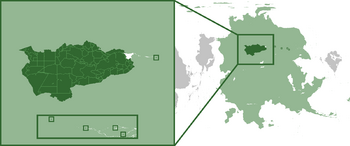S'Lanter: Difference between revisions
SouprRacwn (talk | contribs) No edit summary |
SouprRacwn (talk | contribs) No edit summary |
||
| Line 146: | Line 146: | ||
==Origin of the Okurluns (Aglācā period)== | ==Origin of the Okurluns (Aglācā period)== | ||
===Kveutonian experimentation=== | ===Kveutonian experimentation=== | ||
===Migration from | ===Migration from Central Lumaria=== | ||
===Clan feuds=== | ===Clan feuds=== | ||
===First proto-state=== | ===First proto-state=== | ||
Revision as of 03:01, 1 October 2023
This article is incomplete because it is pending further input from participants, or it is a work-in-progress by one author. Please comment on this article's talk page to share your input, comments and questions. Note: To contribute to this article, you may need to seek help from the author(s) of this page. |
The Okur-Federation of The S'Lanter S'Lanter Okur-Federativnl | |
|---|---|
| Anthem: Sartqelisk'en qe Qagh ("Homeland and Promise") | |
 Location on Pelia continent | |
| Status | Independent State |
| Capital | Velmegun |
| Largest | Akan'aktid |
| Official languages | Okur'langun |
| Demonym(s) | S'Lanter-lun (sing), S'Lanter (adj), S'Lanter (plur) |
| Government | Federal heptarchic representative republic |
• Principal General | Grekor pol Tegiz |
| Independent | |
| Population | |
• 1610 AR census | 101,432,390 |
| GDP (nominal) | estimate |
• Total | Ξ5.64 trillion (₭2.12 trillion PRK) |
• Per capita | ₭20,990.10 |
| Gini (1610) | .38.7 low |
| HDI (1610) | 0.821 very high |
| Currency | Okur'azhk (Ξ) (OZK) |
| Date format | mm/dd/yyyy |
| Driving side | right |
| Calling code | +7 |
| Internet TLD | .sl |
The S'Lanter, officially referred as The Okur-Federation of The S'Lanter, is a landlocked nation located in the southwest of Lumaria on the continent of Pelia. It consists of 87 holts (federal districts) and five unincorporated territories. With a population of over 100 million, it is the most populous country in Lumaria and in Pelia. It is the predominate nationstate of the Okurluns, a species of sapient bipedal Okur'oden. While Okurluns make up 96.3% of the population, members of other species claim citizenship in the Okur-Federation.
Etymology
In Okur'langun, S'Lanter holds a profound and ancient origin, roughly meaning "kindred" in a multilateral context. It derives from Zurkha mythology and the deep reverence the people hold for their interconnectedness and kinship. "S'lan" is the archaic form of the Modern Gurtskharuli word "salkhi," meaning "home" or "dwelling." "Ter" is the archaic form of the Modern Gurtskharuli word "ts'ter," translating to "heart." Thus, "S'Lanter" fuses "salkhi" and "ts'ter".
"S'Lanter" first originated from Zurkha texts in the Shenatvari as early as 350 AR, referring to a mythological promised land for the Okurlun peoples. The word adapted from a physical promised land to a spiritual promised land where the Okur can be one people.
In the late 1400s, "S'Lanter" became a term used to signify a common nationhood of the Okurluns as the Prat'chk clan unified the various tribes. With the establishment of the national fiction based on Zurkha philosophy, the superstate of the Okurluns was effectively founded.
History
Origin of the Okurluns (Aglācā period)
Kveutonian experimentation
Migration from Central Lumaria
Clan feuds
First proto-state
Tribal states period
Destruction of the proto-state
Warring Holts Period
Rivalry of the Prat'chk and the Sulikashvili Vong
Unification of the Okurluns
Lead up to the Brothers War
Foundation of the S'Lanter
Modern history
Geography
S'Lanter geographic borders are defined in the west by the Olki Alps, the Trans-Lumarian Steppe in the north, the R'ffti River Valley in the south, and the Trans-Lumarian Aligriftor Lake in the east. While the majority of the land area consists of the open grassland of the Blue Steppe, there are meadows, deciduous forests, isolated mountain ranges, and cold, arid plateaus.

